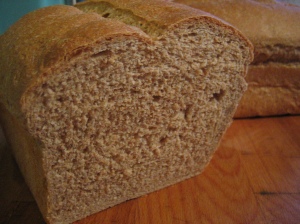I suppose it’s all been building up to this. I’ve been trying to shop the outside of the grocery store. And buy more organic items. I’m reading The Omnivore’s Dilemma by Michael Pollan. Two nights ago we watched Food, Inc. Now I really understand it, the whole enchilada, from local food to sustainable farming, organic, grass-fed, pasture-raised. Food should be good, in all senses of the word:
· Food should be good to the earth, replenishing it and promoting biodiversity.
· Food should be good to those animals who provide it, giving them comfortable happy lives and dignified and painless deaths.
· Food should be good to eat, harvested at its peak.
· Food should be good to the local economy, which means eating vegetables that came from the nearby countryside, not from Peru (unless you live in Peru).
After watching Food, Inc., which I highly recommend, I was resolved to do better but worried that it would break the bank. For example, a regular gallon of milk from Vons is $2.99. It is free of bovine growth hormones, but is not organic and contributes to the industrial food complex. Organic milk is $5.99 a gallon and likely still contributes to the industrial complex but may mean the cows get organic corn instead of el-cheapo corn. What is one to do? Well, start with the big stuff, for one.
The big stuff, in our family, is vegetables and grains. We’ve been trying to buy more vegetables from our local farmer’s market but a lot of the stuff we regularly buy, like carrots, kale, lettuce, and fruit, is often too expensive. Enter CSA! CSA is community-supported agriculture, a way for you to buy direct from the farmer without even the middleman of a farmer’s market. Often you will arrange for a regular (weekly, bi-weekly, or monthly) delivery of a basket of products. These products are often selected by the farmer according to what’s in season. You pick up your basket from a drop-off point and leave your old basket. You pay a subscription fee and get the freshest and most local fruits and vegetables, for a price comparable to grocery store generic. I know, this sounds revolutionary! Well, consider the milkman, bringing fresh milk, butter, and eggs to people’s houses, usually from a local farm. This guy looks happy:
And with good reason—he’s part of a local system that knits a community together. In the last 50 years we’ve gotten much worse, now buying our eggs at $0.99/dozen from a massive windowless chicken metropolis somewhere hundreds of miles away. And the eggs are worse too! What price do we really pay for low prices?
Okay, okay, you think, I know I have to do better. How? Well, I spent a few hours online looking for CSA providers in my area for meats and vegetables and found both. Based on our current grocery budget, we’ll easily be able to split a CSA basket with another like-minded family, and will get (hopefully) much better food in return. Good food.
For the grains, I am looking into buying organic flour. I did this before but would like larger quantities and white flour as well as whole wheat. Speaking of which, I tried out a new bread recipe last night. My wife got me The Tassajara Bread Book for Christmas, which is a half book half treatise on healthy eating and hippie values. Their basic bread recipe looked like a standard whole wheat sandwich. Then I tried it out and found that the process is a little different. For one, it has four proofs instead of two. You start out with a really wet sponge that rises for 45 minutes. I think this boosts the wheat flavor and really strengthens the dough. It was getting late so I skipped one of the proofs but still got impressive oven spring for a whole wheat, and great flavor and structure. This is the new gold standard for whole wheat sandwich!




Hey—I know that milkman. He used to deliver milk to our front door. I also remember that fabulous 100% saturated fat cream that was on the top of each bottle of milk…yum! We have a cooperative here but, unfortunately, because we're not in Calif., we only can get veg. and fruits in season during select summer months–still worth it though, I think.
I found out that if you live in Northern California, you've got your choice of incredible CSAs and quality food. SoCal is more limited, but I still found some.
My husband and I gave a CSA a trial run last summer. We paid an arm and a leg for the smallest option, and it ended up not being enough to last more than a day or two.
I was so sad. In the Central Valley especially, you'd think that CSA's would be an incredible option.
Erin brings up a good point. We should compare the cost of the CSA box and the amount of food in it to what we would pay at the farmer's market. If it's about the same perhaps we should just stick to buying stuff we know we will eat for sure.